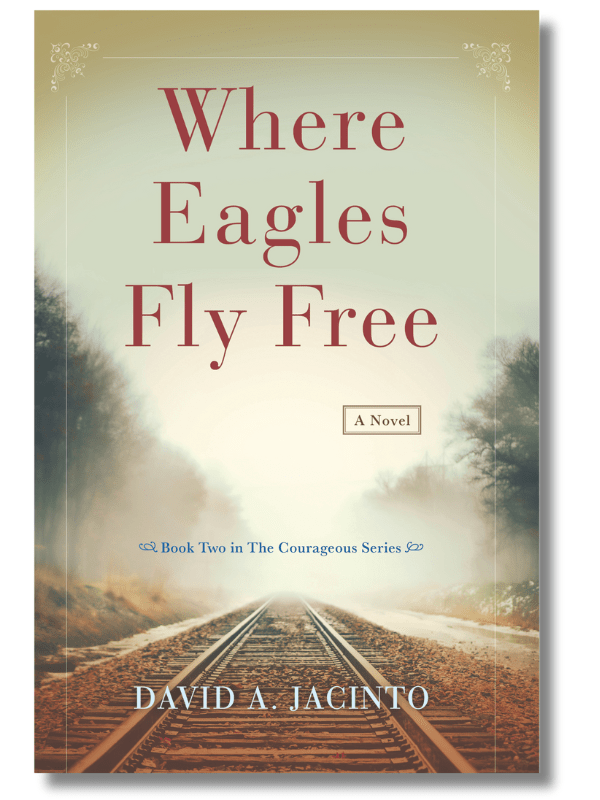Where Eagles Fly Free
by David A. Jacinto
Genre: Historical Fiction / Frontier
ISBN: 9798218497729
Print Length: 406 pages
Reviewed by Lauren Hayataka
Where dreams meet adversity, one family’s odyssey unfolds.
David A. Jacinto’s Where Eagles Fly Free, the second installment in the Courageous Series, is a sweeping historical epic that chronicles the true and tumultuous journey of Thomas Wright and his young wife Annie. They leave the British Isles behind for the promise of freedom in post-Civil War America.
A richly detailed and thoroughly researched narrative, the novel is both an homage to the American immigrant experience and an unflinching examination of the hardships that built a nation.
The novel opens in June 1868 with the Wrights embarking on their long-awaited voyage aboard the Colorado, a perilous journey. Driven from their homeland by industrial aristocrats determined to suppress the common man, Tom, Annie, and Tom’s sister and her family set their sights on the American dream.
Their plan is ambitious: cross the Atlantic, traverse the country by steamer, rail, and wagon train, and carve out a new life in California’s Sierra Nevada mountains. But America, as they quickly learn, is a land of opportunity and unimaginable struggle.
From the outset, Where Eagles Fly Free plunges readers into the brutal realities of 19th-century travel. The Colorado is a stark, mold-ridden vessel where passengers are subjected to lice, malnutrition, and the ever-present threat of disease. There are terrifying storms, too, with crashing waves and mounting tension among the passengers. Their hardships don’t end when they set foot on American soil—far from it.
The Wrights endure racial tensions, exploitative robber barons, Native American conflicts, and the lawless chaos of the Hell-on-Wheels towns that sprang up along the rapidly expanding transcontinental railroad.
Jacinto integrates historical events and figures into the Wrights’ journey, lending an air of authenticity that makes the novel feel as much an educational experience as it is an adventure. Tom’s crucial role in the construction of the transcontinental railroad introduces him to the likes of Brigham Young and General Grenville Dodge, while his unrelenting determination to claim his own piece of America pits him against the unchecked greed of the era’s most ruthless businessmen. Jacinto’s attention to historical detail is evident as he draws from primary sources to shape his depiction of a pivotal moment in U.S. history.
At its core, Where Eagles Fly Free is a novel about survival—not just in the physical sense, but in the fight to hold onto one’s ideals in the face of relentless hardship. Tom is a man of boundless ambition, envisioning America as a land where a man is “only limited by his own ambition, imagination, and willingness to work hard.”
Yet, as he and Annie endure tragedy after tragedy, this idealism is tested, often clashing with the brutal reality of the American frontier. These moments anchor the novel, tempering its sometimes heavy-handed portrayal of freedom and the pursuit of dreams.
Annie’s journey, while intertwined with Tom’s, is distinguished by emotion. While Tom chases his vision of land and legacy, Annie longs for something far more personal: a family, a home, and a place in her husband’s heart. Haunted by Tom’s lingering love for his first soulmate, Lydia, Annie’s struggle to forge a bond with her husband adds an emotional depth that elevates the novel. Her arc is one of quiet resilience, her sacrifices just as meaningful as Tom’s vicious battles with railroad tycoons and warring tribes. Perhaps more so.
The novel’s latter half shifts gears, focusing on the Wrights’ integration into the rapidly changing American landscape and Tom’s work on the Echo Canyon railroad, where he witnesses the corruption and exploitation rampant in the industry. While the American dream is nestled at the heart of Where Eagles Fly Free, it doesn’t shy away from the realities of westward expansion—the appalling racism, greed, and moral compromises that shaped the nation.
Unhurried and thorough, like a mule carefully watching its step while hauling supplies, Where Eagles Fly Free offers an exhaustive look at the period. The prose is evocative and immersive, drawing readers into the era’s grit and grandeur, though it occasionally lapses into exposition, momentarily slowing the novel’s otherwise brisk pace. Yet these are minor quibbles in an excellent narrative that captures the sweeping scope of history and the intimate struggles of those who lived it.
Jacinto has crafted a novel that does not just tell the story of one family’s journey—it encapsulates the larger story of America’s past, with all its triumphs and tragedies. Where Eagles Fly Free is an excellent read, a gripping and heartfelt depiction of the sacrifices made to pursue a dream.
Thank you for reading Lauren Hayataka’s book review of Where Eagles Fly Free by David A. Jacinto! If you liked what you read, please spend some more time with us at the links below.
The post Book Review: Where Eagles Fly Free appeared first on Independent Book Review.
